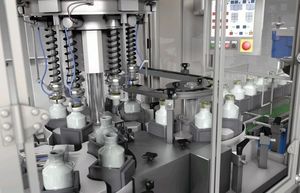The demands of filling and capping machines are extremely dissimilar. The sheer variety of applications and the required flexibility set the bar high for the automation solution. In addition to ensuring the automated processes, the high cycling rate of the machines is the primary focus. Especially when it comes to medical substances, impairing the quality of the medium to be filled must be excluded. As these products are also very high-price, as lossless ramp-up and emptying the line as possible, yet maintaining high system availability is required.
Small batches require flexible filling systems. Short changeover times and almost tool-free size-change of packaging materials are a must, especially, if production is transferred to contract manufacturers. Due to frequent product changes, contract manufacturers need highly flexible systems for best utilization. This means that on one and the same machine a wide range of packaging materials can be processed or various filling systems can be operated.
Filling systems with specific in-process control and automated control loops are state of the art. They grant realtime tracking and, if needed, correction of the filling process.
Even for changeover between labeling formats, the machine should not need to be stopped. Just the data set needed for printing should have to be exchanged without any time delay.
Downtimes for batch or format changeovers or for maintenance have to be continuously minimized or even avoided. Overall Equipment Effectiveness and Total Cost of Ownership play an increasingly significant role. These trends lead to many applications being implemented on just one machine platform.
For this reason, machine concepts which best support customer-specific objectives are needed on the market. These also include remote maintenance permitting access to the control system of the respective plant via protected data connection (VPN) after release by the operator. This way, specialists gain, by remote diagnostics, within a very short time an overall view of the machine situation and thus support its operator effectively.
Jetter AG have been supplying highly specialized systems as both complete and partial solutions that can help you achieve a decisive competitive advantage for machine builders of filling and capping machines. Whether you are processing pharmaceutical, cosmetic or chemical products on your machines – with the integrated solutions from Jetter AG, you ensure significant performance increases in your plants especially when filling liquid media into glass or plastic vials, ampules or cartridges, or when capping and labeling the containers. For this, remote maintenance ability is a matter of course.
The JetControl control systems from Jetter AG take all aspects of the demands for modern automation solutions into account. The seamless integration of motion control and sequential control into one system enable highly flexible solutions. The integration of data management in the JetControl system and the direct connection to ERP, PDA and MES software are a matter of course. The integrated data flow from peripheral devices, up to the process control level, makes production of very small batch sizes economical. This way, mechanical engineers become fit for much-vaunted Industry 4.0.
With combinable and synchronizable axis groups, Motion Control from Jetter AG integrated into JetControl systems guarantees the highest flexibility when designing your filling and capping machines. The Tool Center Point approach simplifies and streamlines the programming of axis groups. This means that programming and commissioning of a plant requires only one control system with one programming language which includes all automation functions. As the classic boundaries between I/O control, operation, networking and drives have been eliminated, the system ensures maximum flexibility with the highest efficiency at engineering the production process. The whole automation infrastructure is available to the user without any limitations.
The special features of an integrated automation concept can very well be illustrated by the example of filling and capping, as well as labeling processes.
Filling
Generally, a distinction is made between linear and rotatory filling machines. On linear filling machines, several containers are filled at the same time. For this purpose, the filling needle carrier moves in sync with the conveyor. The process follows the principle of the flying shear.
On a rotary filling machine, the containers pass through a carousel. The filling process takes place as the containers pass through. Thereby, the dosing amount and filling needle height are individually controlled.
In both cases, the dosing pumps are controlled during the filling process in such a way that the complete process takes place during the synchronous movement. Thereby, the filling needles are always in the optimum position. Depending on the respective medium, the filling needle is kept above (above-level filling) or below the level of the liquid (below-level filling). Especially for aseptic filling, control of the filling needle position is important. The electric cam disc guarantees that a constant distance between the needle and the surface of the medium is maintained. This way, spraying or foaming of the medium is prevented. Regulation of the filling needle height is always in sync with the flow rate. For this, servo-controlled dosing pumps safeguard highly precise dosing. This way, adjusting to higher machine cycles becomes very easy. Dynamic changeover or even new calculations during the runtime of electronic cams enable format changeover for product change at any time.
Capping
In the next step, the filled containers are capped. Different kinds of caps are applied here: Modern high-performance closure machines are distinguished by a high flexibility when sealing different container types. The machines automatically seal the widest array of press-on, screw and orientation closures such as rubber stoppers, freeze-dry stoppers, dropper inserts, screw closures, press-on closures, crimp caps, pipette closures, pilfer-proof caps, and dosing and spray pumps.
The closure process is an intermittent or contiuous process. In the process, the orientation of molded closures with special shapes (recessed grips, asymmetrical outer contour) which require a particular alignment is checked before the cap is placed in the required position. The individual configuration of closure parameters, torque, angular position, number of rotations and speed to allow for a format change can be simply and quickly realized. Today, servo-controlled screw-capping is state of the art. Servo-controlled screw-capping machines with look-ahead limit stop detection actively brake before the limit stop. This enables both rapid and precise screw capping. There will be no individual torque sensor be needed, which would mean there are additional costs.
The flexibility at configuring and programming the capping process allows for optimum customized capping solutions. This way, mechanical engineers can be sure their know-how remains in the company.
Labeling
In many cases, labeling the containers directly follows the capping process. Round container and special shapes such as bottles or tubes pose a great challenge to the automation concept of labeling machines. Often, circumferential labels adapted to the design and size are frequently affixed, which requires a special construction of the machine. At the same time, retooling the system should be as quick as possible in order to flexibly realize the labeling of small and medium batches as well. Precisely positioning the label is an important quality feature of the completed product. Label and container conveyors must be synchronous as regards speed and position. Correct positioning is achieved by synchronization with the conveyor belt with print-mark recognition. For correct positioning, position offsets, triggers, and print-marks can be freely combined. This helps to create customized labeling functions which best fit the product range.
Drives can be flexibly selected while programming remains identical. This way, the mechanical engineer can achieve scalability as regards price and performance by selecting a stepper motor, DC motor, or servo motor.
Summary
Automation solutions by Jetter AG for filling, capping and labeling achieve the shortest cycle times. Highest productivity and constantly high process reliability accompanied by flexibility significantly contribute to a high degree of OEE.
Thanks to seamless integration of control, drive and operating functions, important resources can be saved at programming already. By this, the mechanical engineer can also benefit from this during commissioning and service visits.
The demands that filling systems are expected to meet are becoming ever higher. Machines are expected to be faster, more efficient and more economical at the same time. Tool-supported calculation of the ideal path will track down the perfect parameters. This keeps all motions in the optimum range - smoothly but nevertheless responsively. Energy consumption and wear can therefore be reduced to a minimum.
Profit from the advantages of modern, sophisticated systems by Jetter AG, also with regard to maintenance. No specialized programming skills are required. A screwdriver and a USB flash drive or SD card are all you need. This helps you to update parameters, application programs and firmware to the state of the art or save machine data. Further, the automation system can be easily accessed via protected data connections. This way, experts can provide remote support.
Automation solutions by Jetter AG comprise controlling, driving, operating and networking with the company's IT in one system. Transparent data management of control systems according to Industry 4.0, as well as direct connectivity to SQL databases, ERP, PDA and MES software enable economical production starting at batch sizes of 1.




